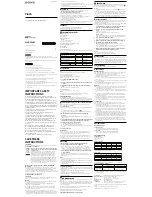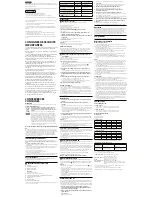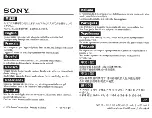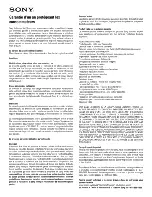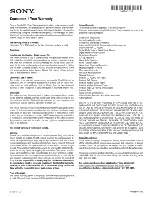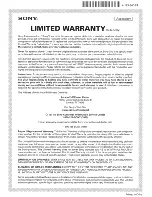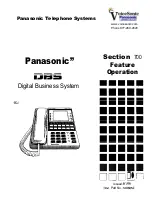
Flash
Reorient or relocate the receiving antenna.
Increase the separation between the equipment and receiver.
Connect the equipment into an outlet on a circuit different from that to which the
receiver is connected.
Consult the dealer or an experienced radio/TV technician for help.
Before Use
For details, refer to the operating instructions supplied with your camera.
This unit is not dust-proof, splash-proof or waterproof.
Do not place this unit in the following locations
Regardless of whether this unit is in use or in storage, do not place it in any of
the following locations. Doing so may lead to a malfunction.
Placing this unit in locations subject to direct sunlight such as on dashboards or
near a heater may cause this unit to deform or malfunction.
Locations with excessive vibration
Locations with strong electromagnetism
Locations with excessive sand
In locations such as the seashore and other sandy areas or where dust clouds occur,
protect this unit from sand and dust. This may lead to a malfunction.
Features
Simple, compact external flash with 24 mm slim design.
Has an automatic white balance adjustment function.
Red-eye reduction flash capability
Identifying the Parts
1
Flashtube
2
BOUNCE switch
3
Lock ring
4
Multi Interface foot
Notes
Do not touch with your hand.
5
Connector protect cap
6
TELE switch (default: Standard position)
7
Battery compartment cover
8
CHG lamp
9
POWER lamp
10
Shoe POWER switch
The status of the CHG lamp and POWER lamp changes as follows according to the
condition of this unit:
Condition of unit
CHG lamp
POWER lamp
During charging
Off
Green light
When charging is completed
On
Green light
When the proper exposure is
achieved after shooting
Blinks
Green light
When batteries are low
Off
Red light
When this unit is overheated
Off
Red blinking light
When camera setting is
[Flash off]
Off
Green light
Preparation
Inserting batteries
Install batteries in this unit and then attach this unit to your camera.
Use either of the following battery pairs:
Two AAA alkaline batteries
Two AAA nickel-metal hydride (Ni-MH) batteries
Batteries are not included.
1 Set the shoe POWER switch to OFF.
Default: ON
2 Press the battery compartment cover in the direction illustrated
to open it.
3 Insert the batteries into the battery compartment as marked
inside.
Make sure the batteries are installed correctly.
4 Close the cover.
Do the reverse procedure to open the cover.
Notes
Be careful not to pinch your fingers when opening and closing the battery
compartment cover. Careless handling may cause injury.
Checking batteries
The POWER lamp of this unit lights up red when the batteries are low.
If neither the CHG lamp nor the POWER lamp lights up when the shoe POWER
switch is set to [ON], check if the batteries are installed correctly. If the batteries are
installed correctly but the lamps still do not light up, replace the batteries.
Attaching this unit to your camera and turning it on
Remove the connector protect cap and make sure the lock ring is not locked.
Make sure the camera is switched off.
1 Turn this unit on.
When you flip this unit up until it clicks, it turns on and the POWER lamp lights
up.
To turn this unit off, flip it down. (see illustration
-
1
)
This unit may touch some models of camera or interchangeable lens when it is
turned off.
2 Make sure the built-in flash of your camera is in the down
position.
If your camera has a built-in flash and the flash is in the up position, return it to
the down position.
3 Insert the Multi Interface foot of this unit all the way into the Multi
Interface Shoe of your camera in the direction of the arrow.
4 Turn the lock ring to lock this unit in place.
Do not turn the lock ring with excessive force.
To remove this unit, perform the above steps in reverse.
The lock ring does not lock automatically. Turning the lock ring with force may
unlock it.
5 Turn your camera on.
Power save
If you do not operate your camera or this unit for more than 1 minute after your
camera has entered the power save state, this unit automatically turns off to save
power, and the POWER lamp and CHG lamp turn off.
This unit also enters the power save state when you set the POWER switch of
your camera to [OFF] (with all Sony digital single lens reflex cameras except the
DSLR-A100).
To exit the power saving state, turn this unit back on or operate your camera.
Shooting
1 Make sure that your camera and this unit are turned on.
2 Set your camera to the desired shooting mode.
Refer to the operating instructions of y our camera for shooting modes.
When you set your camera to shutter speed priority (S) mode or manual exposure
(M) mode, you cannot select a shutter speed faster than the flash sync speed*.
* Flash sync speed is the maximum shutter speed that you can use with a flash.
3 After charging of this unit is completed, press the shutter button
to shoot a subject.
When charging is completed, the CHG lamp of this unit turns amber.
When the proper exposure can again be obtained after shooting, the CHG lamp
blinks amber.
Notes
If you shoot before charging is completed, you may not be able to get enough
lighting (under exposure).
When using the flash in self-timer shooting, make sure that charging is completed
before pressing the shutter button.
When your camera is in auto flash mode, the flash may not fire depending on the
lighting conditions.
Overheat protection
Overheat protection is a function for protecting this unit from overheating. If this unit
gets warm when used in continuous flash mode or in a hot environment, flash firing is
automatically disabled.
When overheating is detected, the POWER lamp blinks in red at one-second
intervals.
Flash firing cannot be re-enabled until this unit cools down.
When this unit is in an overheated state, leave it without any operation for 10
minutes to cool down.
BOUNCE Switch
If you fire a flash directly at a subject just in front of a wall, harsh shadows appear on
the wall.
When shooting in a room with a low ceiling, you can soften these shadows by setting
the BOUNCE switch to [BOUNCE] so that the flashtube of this unit tilts upward and
emits light at the ceiling. Light reflects off the ceiling and illuminates the subject to
produce a soft-lit image.
In outdoor shooting, setting the BOUNCE switch to [DIRECT] lets you illuminate a
subject at a distance that a built-in flash cannot reach.
BOUNCE: the flashtube is set at 75 degrees upward (bounce flash)
DIRECT: the flashtube is set at 0 degrees (direct flash)
Slide the BOUNCE switch to the desired position.
Printed in China
HVL-F20M
© 2013 Sony Corporation
Operating Instructions/Mode d’emploi
4-469-462-
11
(1)
TELE Switch
If a subject is too far to be reached by the flash from this unit (the subject is out of
flash range), set the TELE switch of this unit to [Tele position] (see illustration
-B
).
The flash from this unit can now reach a further range.
Notes
Set the TELE switch to [Standard position] (see illustration
-A
) for regular
shooting.
If the lens angle is wider than the selected flash angle, the outer areas of the image
may become dark. See “Zoom flash range” for the flash range of each position.
The TELE switch is enabled only when the BOUNCE switch is set to [DIRECT].
If this unit is attached to a camera with a built-in flash that operates as an AF
illuminator, AF accuracy may be greatly reduced in night view shooting.
Wireless Control
You can attach this unit to a compatible camera and use it as a wireless controller
for an off-camera flash. An off-camera flash means a flash positioned away from the
camera that is being use for shooting.
In this manual, a flash attached to the camera is referred to as a controller and a flash
used separately from the camera is referred to as an off-camera flash.
1 Connect this unit to your camera, and set the power switches of
your camera, off-camera flash and this unit to [ON].
2 Set the mode of your camera and off-camera flash as follows.
Camera:
Set the mode to [Wireless].
Refer to the operating instructions of your camera for details.
Off-camera flash:
Set the off-camera flash to [Wireless remote mode] and the wireless channel to
[CH1]. Refer to the operating instructions of your off-camera flash for details.
3 Set your camera and off-camera flash.
Refer to the operating instructions of your off-camera flash for how to set it.
4 Make sure the off-camera flash and this unit are fully charged.
5 Fire a test flash to check the off-camera flash.
The flash test differs depending on the camera. Refer to the operating
instructions of your camera.
If your off-camera flash does not fire, change the position of your camera, off-
camera flash and the subject and try a test flash again.
6 Make sure that this unit and your off-camera flash are charged,
and press the shutter button fully down to shoot.
Notes
This unit cannot be used as an off-camera flash.
Lighting ratio control setting (RATIO) is not available.
Maintenance
Remove this unit from your camera and wipe it with a dry soft cloth. Lightly blow
any sand off this unit. Scrubbing it before blowing sand off may scratch the surface of
this unit. To remove stains, wipe them off with a cloth lightly dampened with a mild
detergent, and then wipe the unit clean with a dry soft cloth. Never use strong solvents
such as thinner or benzine, otherwise the surface finish will be damaged.
Compatibility
For compatible models, refer to Sony websites, catalogues, etc.
Notes on Use
During shooting
Do not fire the flash directly in front of someone’s eyes. It produces strong light.
Do not fire the flash 20 or more times in succession. Doing so can cause
overheating and deterioration of this unit and its batteries.
If you fire the flash a certain number of times in succession, leave it to cool down
naturally for at least 10 minutes.
Do not carry your camera by holding this unit when it is attached. Always hold the
camera itself.
Do not carry the camera in a bag etc. with this unit attached. Doing so may damage
the camera or this unit.
When changing the shoe POWER switch to the [OFF] position, be careful not to
catch your finger in the hinge. It may cause injury.
Batteries
The displayed battery level may be lower than the actual battery capacity depending
on the temperature and storage conditions. The displayed level usually becomes
accurate after you use this unit a few times.
The output of Nickel-metal hydride batteries drops suddenly when the batteries
become low. You may not be able to use this unit soon after the POWER lamp turns
red.
The frequency and number of flashes of this unit may be different from those
shown in the specification table even when new batteries are installed, depending
on their date of production.
Turn the power off and wait several minutes before removing the batteries. Be
careful when touching the batteries because they may be hot, depending on the
battery type and conditions of use.
Remove and store the batteries if you do not intend to use this unit for a long time.
Temperature
The operating temperature range of this unit is between 0 °C and 40 °C.
Do not expose this unit to extremely high temperatures (e.g. in direct sunlight
inside a vehicle) or high humidity.
A drastic temperature change may cause condensation inside this unit. When
bringing this unit from a cold place such as a ski slope to a warm place, first put
it in a plastic bag, remove the air from the bag and seal it. After bringing it to the
warm place, leave it for a while until it reaches room temperature and then remove
it from the bag.
Battery output decreases as temperature decreases. When using in a cold
environment, use new batteries or prepare spare batteries kept warm and use them
interchangeably with another set. The POWER lamp may temporarily turn red in
a cold environment even though the batteries still have remaining capacity. If the
battery output becomes low due to low temperature, leave the batteries indoors
until they reach room temperature. The battery output will return to normal.
This unit is not waterproof. When using this unit on a beach, be sure to keep it
away from water or sand. Any water, sand, dust, or salt remaining in this unit may
cause a malfunction.
Specifications
Zoom flash range
Standard position
APS-C format: equivalent to the 18 mm focal length range
35 mm-format: equivalent to the 27 mm focal length range
Tele position
APS-C format: equivalent to the 35 mm focal length range
35 mm-format: equivalent to the 50 mm focal length range
Flash length range
Guide number
Standard position: 14
Tele position: 20
*ISO100
Standard position
Aperture (F)
ISO100
ISO200
ISO400
ISO800
2.8
1-5
1-7
1-10
1-14
4
1-3.5
1-5
1-7
1-10
5.6
1-2.5
1-3.5
1-5
1-7
8
1-1.5
1-2.5
1-3.5
1-5
* When the BOUNCE switch is set to [DIRECT]
(unit: m)
Tele position
Aperture (F)
ISO100
ISO200
ISO400
ISO800
2.8
1-7
1-10
1-14
1-20
4
1-5
1-7
1-10
1-14
5.6
1-3.5
1-5
1-7
1-10
8
1-2.5
1-3.5
1-5
1-7
* When the BOUNCE switch is set to [DIRECT]
(unit: m)
Flash interval/Number of flashes
Alkaline batteries
Ni-MH batteries (930 mAH)
Flash interval (sec)
Approx. 0.1-5
Approx. 0.1-4
Number of flashes
(times)
Approx. 90 or more
Approx. 150 or more
Number of flashes refers to how many times this unit can flash with new batteries
until they run down.
Flash control
Pre-flash light metering (P-TTL/ADI flash metering)
Dimensions (Approx.)
62 mm × 114 mm × 24 mm (w/h/d)
(2 1/2 in. × 4 1/2 in. × 31/32 in.)
Mass
Approx. 105 g (3.7 oz) (without batteries)
Recommended
AAA alkaline batteries
batteries
AAA Ni-MH batteries
Included items
Flash (1), Connector protect cap (fitted to main unit) (1),
Carrying pouch (1), Set of printed documentation
Values of functions given in these operating instructions are based on trials performed
by Sony.
Design and specifications are subject to change without notice.
“Multi Interface Shoe” is a trademark of Sony Corporation.
The HVL-F20M is a flash for use with a Sony video camera recorder or
interchangeable lens digital camera that has a Multi Interface Shoe (referred to below
as “camera”).
Before operating the product, please read this manual thoroughly and retain it for
future reference.
WARNING
To reduce the risk of fire or electric shock,
1) do not expose the unit to rain or moisture.
2) do not place objects filled with liquids, such as vases, on the apparatus.
Keep out of reach of small children to prevent accidental swallowing.
Do not expose the batteries to excessive heat such as sunshine, fire or the like.
Tape over lithium battery contacts to avoid short-circuit when disposing of batteries,
and follow local regulations for battery disposal.
Keep batteries or things that could be swallowed away from young children.
Contact a doctor immediately if an object is swallowed.
Immediately remove the batteries and discontinue use if...
the product is dropped or subjected to an impact in which the interior is exposed.
the product emits a strange smell, heat, or smoke.
Do not disassemble. Electric shock may occur if a high voltage circuit inside the
product is touched.
IMPORTANT SAFETY
INSTRUCTIONS
When using your photographic equipment, basic safety
precautions should always be followed, including the following:
Read and understand all instructions before using.
Close supervision is necessary when any appliance is used by or
near children. Do not leave appliance unattended while in use.
Care must be taken as burns can occur from touching hot parts.
Do not operate appliance with a damaged cord or if the appliance
has been dropped or damaged- until it has been examined by a
qualified serviceman.
Let appliance cool completely before putting away. Loop cord
loosely around appliance when storing.
To reduce the risk of electric shock, do not immerse this
appliance in water or other liquids.
To reduce the risk of electric shock, do not disassemble this
appliance, but take it to a qualified serviceman when service or
repair work is required. Incorrect reassembly can cause electric
shock when the appliance is used subsequently.
The use of an accessory attachment not recommended by the
manufacturer may cause a risk of fire, electric shock, or injury to
persons.
Batteries may become hot or explode due to improper use.
Use only the batteries specified in this instruction manual.
Do not install the batteries with the polarity (+/-) reversed.
Do not subject batteries to fire or high temperatures.
Do not attempt to recharge (except for rechargeable batteries),
short or disassemble.
Do not mix, batteries of different types, brands or ages.
SAVE THESE
INSTRUCTIONS
CAUTION
Do not touch the flashtube during operation, it may become hot when the flash fires.
For customers in Europe
Disposal of Old Electrical & Electronic Equipment (Applicable in
the European Union and other European countries with separate
collection systems)
This symbol on the product or on its packaging indicates that this
product shall not be treated as household waste. Instead it shall
be handed over to the applicable collection point for the recycling
of electrical and electronic equipment. By ensuring this product
is disposed of correctly, you will help prevent potential negative
consequences for the environment and human health, which could
otherwise be caused by inappropriate waste handling of this product.
The recycling of materials will help to conserve natural resources.
For more detailed information about recycling of this product, please
contact your local Civic Office, your household waste disposal service or
the shop where you purchased the product.
Notice for the customers in the countries applying EU
Directives
This product has been manufactured by or on behalf of Sony Corporation, 1-7-1
Konan Minato-ku Tokyo, 108-0075 Japan. Inquiries related to product compliance
based on European Union legislation shall be addressed to the authorized
representative, Sony Deutschland GmbH, Hedelfinger Strasse 61, 70327 Stuttgart,
Germany. For any service or guarantee matters, please refer to the addresses provided
in the separate service or guarantee documents.
For the customers in the U.S.A.
CAUTION
You are cautioned that any changes or modifications not expressly approved in this
manual could void your authority to operate this equipment.
NOTE:
This equipment has been tested and found to comply with the limits for a Class B
digital device, pursuant to Part 15 of the FCC Rules.
These limits are designed to provide reasonable protection against harmful
interference in a residential installation.
This equipment generates, uses, and can radiate radio frequency energy and, if
not installed and used in accordance with the instructions, may cause harmful
interference to radio communications.
However, there is no guarantee that interference will not occur a particular
installation. If this equipment does cause harmful interference to radio or television
reception, which can be determined by turning the equipment off and on, the user is
encouraged to try to correct the interference by one or more of following measures:


